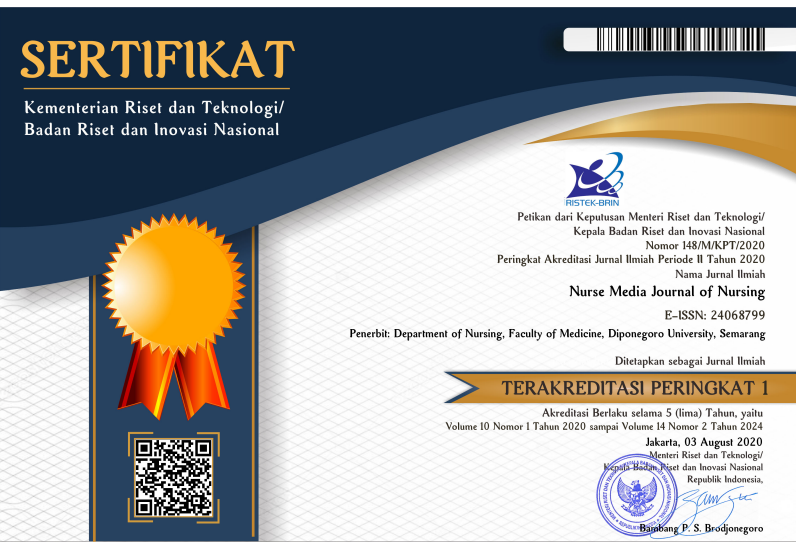The Role of Nurses as Educators for Healthy Toilet Ownership in Southwest Aceh District, Indonesia in 2024
Keywords:
Nurse , ToiletAbstract
Lack of sanitation facilities causes serious health risks that affect billions of people around the world, in West Aceh from 152 villages only 21 villages are Open Defecatiin free. This study was to see how the role of nurses as educators influences the ownership of healthy latrines. This research method uses a cross-sectional study design. with bivariate analysis using the Chi-Square statistical test. Thenumber of samples in this study was 81 respondents who were randomly selected and spread across sub-districts in rural areas of West Aceh Regency, Aceh Province. The results of this study found that as many as 32.1% of respondents who had healthy latrines were dominated by respondents who stated that the role of nurses as educators was good, and as many as 92.0% of respondents who did not have healthy latrines were dominated by respondents who stated that the role of nurses as educators was lacking. The results of the Chi Square statistical test obtained a P-value = 0.040 which stated that there was a significant influence of the role of nurses as educators on the ownership ofhealthy latrines. So it can be concluded that nurses as educators have a fairly good role in educating the community about increasing ownership of healthy latrines. Support from the government and other sectors is needed through ongoing training programs, in order to increase the number of nurse human resources as educators who can influence the wider and more evenly distributed community regarding the ownership of healthy latrines throughout the Southwest Aceh Regency.
Downloads
References
Prüss-Üstün A, & Corvalán C, 2006. Preventing disease through healthy environments. Towards an estimate of the environmental burden of disease, Geneva: World Health Organization.
Amelia, RN., Halim, RD., & Lanita, U, 2021. Factors related to toilet ownership in Sungai Itik Village, Sadu District, East Tanjung Jabung Regency in 2021. e- SEHAD,, Volume Volume 1, Number 2, pp. 52-62.
Anon., 2019. Environmental Sanitation Management in Regional Development in Serang City.. Journal of Economics, Volume 9(2), p. pp. 178–199.
Central Statistics Agency (BPS), 2017. Analysis of BPS Data for Southwest Aceh Regency in 2017, Southwest Aceh: BPS Southwest Aceh.
Barnard, et.al, 2013. Impact of Indian Total Sanitation Campaign on latrine coverage and use: A cross-sectional study in Orissa three years following program implementation. PLOS ONE, pp. 8, e71438.
Coffey, D.et.al, 2014. Revealed preference for open defecation. Econ. Polit. Wkly,
Volume 49, p. 43–55..
Garn JV et.al, 2017. The impact of sanitation interventions on latrine coverage and latrine use: A systematic review and meta-analysis. Int. J. Hyg. Environ. Health, Volume 220 2 Pt B, p. 329–340.
Hayati, Y., 2021. Factors related to Ownership of Healthy Toilets in Pasi Aceh Tunong Village, Mereubo District, West Aceh Regency. Jurmakemas, Volume Volume 1 Number 2.
Heranita L, Lubis NL., & Moriza T, 2019. Factors Influencing Family Behavior in the Use of Toilets in the Air Pinang Village Settlement, East Simeulue District, Simeulue Regency in 2018. Cehadum Health Journal, Volume 1 (3).
Joseph & Warouw, 2018. Factors Related to the Availability of Healthy Family Toilets in Tompaso Dua Village, West Tompasso District, Minahasa Regency. Journal of Public Health, Volume 3, pp. 1-6.
Ministry of Health of the Republic of Indonesia, 2014. Regulation of the Minister of Health of the Republic of Indonesia Number 3 of 2014 concerning Community-Based Total Sanitation, sl: Ministry of Health, RI.
Ministry of Health of the Republic of Indonesia, 2016. Family and Community Nursing, Jakarta: Ministry of Health of the Republic of Indonesia.
Ministry of Health of the Republic of Indonesia, 2020. Smart STBM Data, Jakarta:
Ministry of Health of the Republic of Indonesia.
Marjinto, 2021. The Relationship between the Role of Nurses as Educators in Families Using Healthy Toilets to ODF Villages in the Banyuasin Health Center UPT Area, sl: sn
Meri & Risti, 2020. Factors Related to Ownership of Healthy Toilets by Households in Indonesia (Literature Review). Journal of Students and Health Research, Volume 7(1), p. pp. 1–15.
Oktanasari, W., Laksono, B. & Indriyanti, DR, 2017. Determinant Factors and Community Response to the Utilization of Toilets in the Katajaga Program in Gunungpati District, Semarang. Public Health Perspective Journal, Volume 2(3), p. pp. 279–286.
Putra, et.al, 2021. Counseling on the 5 Pillars of STBM (Community-Based Total Sanitation) for the Brangkal Village Community.. Community Service Journal, Volume 5 (1), pp. 27-33.
Sayati, 2018. Factors influencing the utilization of healthy toilets in the working area of 23 Ilir Health Center Palembang. Jurnal 'Aisyiyah., Volume 2.
Sugiyono, 2011. Quantitative, Qualitative and R&D Research Methods. Bandung: Afabeta.
Suryani, DHS a. S., 2020. Ownership of Healthy Toilets in Coastal Communities in Binjai Village, West Bunguran District, Natuna Regency. World Public Health Journal, pp. 9(3), pp. 346–354.
WHO, UNICEF, 2015. Progress on sanitation and drinking water—2015 update and MDG assessment. , Geneva, New York City:: WHO and UNICEF.
Widiastuti, 2019. Environmental Sanitation Management in Regional Development in Serang City.. Journal of Economics,, Volume 9(2), p. pp. 178–199.
Zeleke, et.al, 2019. Community -Led Total Sanitation and the rate of latrine ownership. BMC Research Notes, pp. https://doi.org/10.1186/s13104-019-4066- x.






